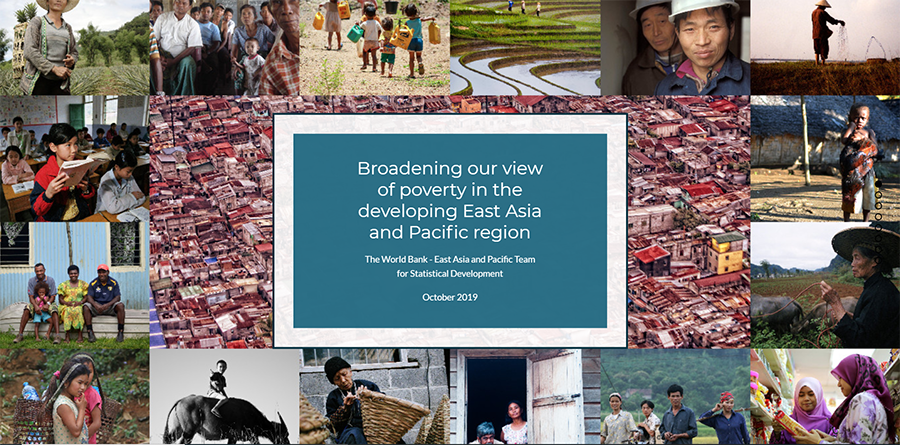The East Asia and Pacific (EAP) region is often characterized as a global success story in terms of the amount and pace of poverty reduction over the last few decades. Indeed, over the last half century, a billion people have been lifted out of extreme poverty.
However, a broader view of poverty and mobility shows there is still much to be done even though extreme poverty is now less prevalent.
In the last year, two pieces on poverty and mobility in developing EAP countries were prepared for East Asia and Pacific Economic Updates. Some highlights from these articles are summarized below.
Piecing together the Poverty Puzzle in the developing East Asia and Pacific region
-
While extreme poverty is nearly eradicated, the international poverty line may now be too low to identify if someone is poor in developing EAP
In 2019, an estimated 26 million people remain in extreme poverty as measured by the International Poverty Line (IPL, $1.90/day 2011PPP), about 1.2% of the total population. In the region's more prosperous countries, such as China, Malaysia, and Thailand, extreme poverty rates are less than 1%.
As countries have grown economically, the yardstick for measuring extreme poverty based on the International Poverty Line (IPL) has gradually become less relevant to the developing East Asia and the Pacific, which is today comprised of mostly lower and upper middle-income countries. Monitoring poverty using higher standards is increasingly important as countries grow richer, and people's conceptions of poverty and the standards of living they aspire to are much higher.
-
A half billion people are still economically insecure, living on less than $5.50 a day
The majority of people in developing EAP are at least economically secure, but a half billion still live on less. In 2019, 496 million people in developing EAP were economically insecure (defined as those living below $5.50/day 2011PPP). The number of economically insecure is nineteen times greater than the number of extreme poor. The largest differences in the number of extreme poor and the number of economically insecure can be found in the region’s most populous countries. For example, in 2019, about 4 million Chinese were extreme poor, compared with 224 million economically insecure.
-
Multidimensional poverty is 50% higher than monetary poverty
A multidimensional measure of poverty results in a 50% higher rate of poverty than a purely monetary-based measure of poverty using the $1.90 poverty line. Even in countries where the level of extreme poverty is below 1%, deprivations in non-monetary aspects of life are still present, which reflects the multifaceted nature of poverty. Large variation exists within countries. In particular, material deprivations are much higher in rural than in urban areas. While many countries in developing EAP have made good progress in tackling poverty, many sub-regions still face daunting poverty reduction challenges.
View the accompanying data story about Piecing together the Poverty Puzzle in EAP
Economic mobility across generations in the developing East Asia and the Pacific region
-
Progress in absolute upward mobility in education has been rapid
After decades of rapid improvements, average absolute mobility in education among the latest generation of adults in EAP (those born in the 1980s) is on par with the average for high-income economies and significantly higher than the average for developing economies as a whole. The average share of individuals in EAP countries surpassing their parents in educational attainment has increased from 47% among those born in the 1950s to 56% among those born in the 1980s.
-
EAP lags high-income countries in relative mobility, and upward mobility from the bottom of the income distribution is declining
An intuitive measure is the share of individuals who make it to the top quartile of education attainment in their generation, among those born into the bottom half according to how well their parents are educated.
Measured thus, upward mobility from the bottom to the top is lower than ideal (which would be 25% if a child’s educational mobility was independent of their parent’s education level) almost everywhere. Persistence at the bottom of the educational distribution is becoming more pronounced as measured by large declines in mobility from the bottom half to the top quartile in five out of the 6 developing EAP countries. The share does not exceed 20% in any country in EAP for the 1980s generation. This share is lower than among high-income countries.
-
Gender gaps in educational mobility have almost disappeared
Gender gaps in EAP have been closing steadily, following the global trend of narrowing gender gaps in absolute and relative mobility in education from the bottom to the top. The gender gaps using these two measures were substantial in favor of the boys for the 1940s generation in EAP, but they have all but disappeared for the 1980s generation, mirroring the rapid increases in girls’ education during the intervening time. In Thailand, Mongolia and some of the Pacific island nations, absolute mobility among girls of the 1980s generation is significantly higher than among boys.
Links to Readings:
- To read the full article “Piecing together the Poverty Puzzle in the developing East Asia and Pacific region”, please refer to Part 2A in the Spring 2019’s edition of the East Asia and Pacific Economic Update.
- To read the full article “Economic mobility across generations in the developing East Asia and Pacific region”, please refer to Part 2A in the October 2018’s edition of the East Asia and Pacific Economic Update. The analysis is based on the World Bank report entitled “Fair Progress? Economic Mobility across Generations around the World.” A shortened version of the chapter can be found in the Poverty & Equity Note series.



Join the Conversation